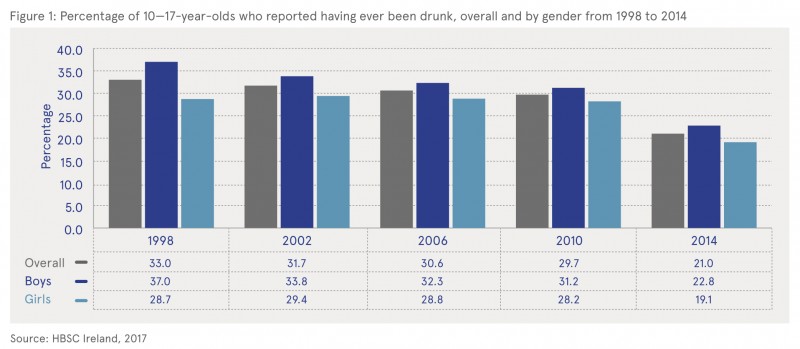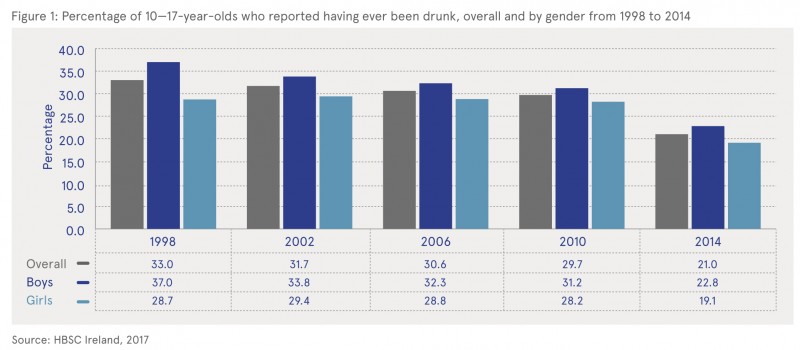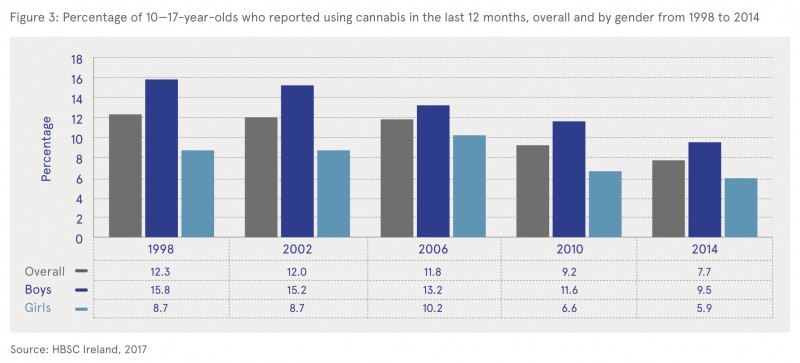Millar, Sean (2017) Trends in alcohol, tobacco and cannabis use among school-aged children in Ireland, 1998—2014. Drugnet Ireland, Issue 63, Autumn 2017, pp. 26-27.
| Preview | Title | Contact |
|---|---|---|
|
PDF (Drugnet Ireland 63)
1MB |
The first Health Behaviour in School-Aged Children (HBSC) survey was conducted in Ireland in 1998 and has been repeated every four years since then. In 2014, the study was conducted in Ireland for the fifth time. This survey included 13,611 children drawn from 3rd class in primary school through to 5th year in post-primary school; 230 primary and post-primary schools across Ireland participated. Data were collected on general health, social class, smoking, use of alcohol and other substances, food and dietary behaviour, exercise and physical activity, self-care, injuries, bullying and sexual health behaviours. This article presents findings from a 2017 report which examined trends in alcohol, tobacco and cannabis use among 10—17-year-old children between 1998 and 2014.1
Alcohol use
Children were asked if they had ever had so much alcohol that they were really drunk. The response options ranged from ‘never’ to ‘yes, more than 10 times’. Findings indicated that there has been a statistically significant decrease in the proportion of children who reported having ever been drunk between 1998 and 2014 (Figure 1). Statistically significant decreases in the proportion of those who had ever been drunk were observed in boys and girls and in children from all age groups, and all social class groups, over time. Overall, 58.2%, 57.2%, 52.7% and 41.2% of 15—17-year-olds reported having ever been drunk in 2002, 2006, 2010 and 2014, respectively. Of those who had ever been drunk, there was a statistically significant decrease between 2002 and 2014 in the proportion of 15—17-year-old boys and girls who reported having their first alcoholic drink aged <11, <13 and <15 years.



Tobacco use
Children were asked how often they smoke at present. The response options ranged from ‘I do not smoke’ to ‘every day’. Current smoking as presented below is defined as smoking monthly or more frequently. Between 1998 and 2014, there was a statistically significant decrease in the proportion of children who reported being a current smoker (Figure 2). Compared to 1998, significantly fewer boys and girls reported being a current smoker in 2014. Over time, statistically significant decreases in the proportion of current smokers were apparent in all age and social class groups. Overall, 61.7%, 54.2%, 46.1% and 27.5% of 15—17-year-olds reported ever having smoked in 2002, 2006, 2010 and 2014, respectively. Of those who had ever smoked, there was a statistically significant decrease between 2002 and 2014 in the proportion of 15—17-year-old boys and girls who reported having smoked their first cigarette aged <11, <13 and <15 years.
Cannabis use in the last 12 months
Children were asked if they had used cannabis in the last 12 months. The response options ranged from ‘never’ to ‘40 times or more’. The findings below present the proportion of children who reported cannabis use in the last 12 months. Between 1998 and 2014, there was a statistically significant decrease in the proportion of children who reported using cannabis (Figure 3). Statistically significant decreases in the proportion of children who reported cannabis use over time were apparent in the majority of the age and social class groups.
International ranking (15-year-olds)
In 2014, 15-year-olds in Ireland were below the international HBSC average for being a current smoker (Ireland 10.8%; HBSC average 17.1%). Ireland ranked 12th in 1998, 20th in 2002, 13th in 2006, 23rd in 2010 and 25th in 2014. With regard to children reporting ever having been drunk, 15-year-olds in Ireland were below the international HBSC average for this indicator (Ireland 27.0%; HBSC average 37.6%). Ireland ranked 18th in 1998, 21st in 2002, 17th in 2006, 17th in 2010 and 21st in 2014. No internationally comparable data were available regarding cannabis use.
Conclusions
In summary, results from the HBSC surveys suggest a decline in the use of alcohol, cigarettes and cannabis among school-aged children in the Republic of Ireland. In a commentary on the report, the Minister of State for Health Promotion at the Department of Health, Marcella Corcoran Kennedy TD, noted that the HBSC surveys provide policy-makers and researchers with access to key data to inform policy and service development. The data are also a key factor in designing policy for the prevention of poor health behaviours and for the promotion of healthy ones.
1 Keane E, Gavin A, Perry C, Molcho M, Kelly C and Nic Gabhainn S (2017) Trends in health behaviours, health outcomes and contextual factors between 1998—2014: findings from the Irish health behaviour in school-aged children study. Dublin: Department of Health and National University of Ireland Galway. https://www.drugsandalcohol.ie/27365/
A Substance use and dependence > Prevalence > Substance use behaviour > Alcohol consumption
A Substance use and dependence > Substance related societal (social) problems > Underage drinking
B Substances > Cannabis / Marijuana
B Substances > Alcohol
B Substances > Tobacco (cigarette smoking)
T Demographic characteristics > Child / children
T Demographic characteristics > Adolescent / youth (teenager / young person)
T Demographic characteristics > Underage drinker
T Demographic characteristics > Student (secondary level)
T Demographic characteristics > Student (primary level)
VA Geographic area > Europe > Ireland
Repository Staff Only: item control page